QuestionAfter researching various reptiles, I just purchased a leopord gecko for my daughter. We bought a 10 gallon aquarium, a "coconut shell" hideout, the retile bowl for water, a porcelain clamp lamp with glow in the dark reflector, and a calcium/vitd3 powder and repti-sand substrate made from very fine, pure quartz.
After getting all of that we forgot to ask how old she was. They said she had just finished shedding yesterday, but still has stripes with various violet and yellow shading with blue around the nose. She is exactly 5" long.
So, after all of that, I was wondering if there is anyway to tell how old she is?
Also, I've noticed a lot of info now saying not to use sand as it causes impaction, while some say at 5'+ it's ok others not ever. I've bought sand that says for use for leopord geckos and is not the regular sand, is very fine. We have a small dish of calcium available to her, so is it ok to use this sand or better off with something else?
Any answers or insight would be great! Thanks!
AnswerHI Amanda,
It looks like you have done your homework!! A few things I suggest changes in are: go to a 20 gallon tank soon. Leos love to explore so the 20 gallon gives them more room. Also, from a health standpoint, its much easier to get all the correct temperatures in a 20 gallon tank. In a 10 gallon there just isn't enough room. Also, adding another hide is recommended so he has his choice of where he wants to "hang out". Have one in the cooler area and one in the warmest area.
As to age...I would venture to say around 3-4 months. At 5 inches, your leo is considered a "sub-adult" The younger they are, the more "colors" (bands) they generally have.
As for sand, those that do choose to take the chance and use it, use children's play sand as they have found it is better than any other sand. MOST choose not to use sand at all for safety reasons. When they are catching an insect, the chance of them eating the sand is very great. Many choose to just eat the sand because it is there. This is especially true for the young ones. This will cause impactions which, can cause death or the need for a very tricky surgery. I like using tile flooring, paper towels, lizard carpet or newspaper. Its easy to clean and its much easier to see if your gecko is going to the bathroom and when he does go to the bathroom, its easy to spot any problems(such as loose movements, parasites, etc) It's one of those its much better to be safe than sorry...and just not use the sand.
I've included a basic care sheet which has two very good links to leopard gecko care.
Leopards are pretty easy to care for but they do need
special care. Here are some of the basic needs of your
gecko.
HOUSING: The need to have at least a 20 gallon long tank for
one Leo. This needs to have a secure fitting screen top...they can be quite the escape artists!!! They need to have a humid hide box.You can make
this with something as simple as a small plastic dish with a
hole cut in one side and a small mesh bag filled with some
Sphagnum moss, coconut bark or Peat moss that you mist.
I use that on the warm side of the tank. Be sure to provide a cool hidebox on the other end. I use the critter caves which you can purchase. NOT the ones that have heat in them!!!!
Provide secure climbing areas for your gecko. Fake plants, rocks and branches are all fine to use.
SUBSTRATE:(that's the stuff on the floor of your tank) News
paper, lizard carpet or paper towels work great and are easy
to clean and are much safer than any loose substrate.
TEMPERATURES: They need a warm area of 88-90 degrees and a
cooler area in the upper 70s, low 80s. At night their
temperature can drop to the low to mid 70's.
Never use a hot rock for a leopard gecko...or any reptile.
They can severely burn any reptile. You can use a heating
pad under the tank, or you can use a regular household
lightbulb in a dome fixture with a ceramic socket in it to
keep the warm area at the 88-90 degree area.At night, no white light. If room temperatures stay above 70 degrees, no extra night heat is needed.
You can use the special nighttime lights that are designed for reptiles. I like using a ceramic heat emitter on a thermostat for nighttime heat.
DO NOT use black lights or party lights as they can cause eye damage!!!!
The wattage you use will vary based on room temperature and size of tank.
LIGHTING: Leopard geckos do not need UVB lighting but it does not hurt them to give them uvb. They should have some type of light during the day, be it a uvb tube, regular florescent light, reptile day light or regular household lightbulb. NO white lights at night!!!
FEEDING: Geckos should not be fed crickets or other insects that are bigger than the space between their eyes. Crickets and other food items such as silk worms, super, and an occasional treat of a wax worm, need to be dusted with a calcium supplement two times a week and also they should have a small dish of calcium in their tank. I use the lid of a milk jug for the little dish of calcium in their tank. For dusting the insects, Use a calcium with no added phosphorus.
Insects must be gut loaded(fed) for at least 48 hours prior to feeding your gecko. Remove any uneaten crix or superworms after 15-20 minutes..... Place a piece of cut potato in the tank so that if you have missed any uneaten insects, they will eat the potato instead of nibbling on your gecko!!!
You have to be sure to feed your crickets the right foods
before feeding them to your gecko. If your crickets/insects are not healthy and well fed, your gecko will not get the nutrition
he needs. You can gut load your crickets greens, veggies, cereals or specially designed commercial foods for crickets or the insects you are feeding.
Be sure to have a small dish of clean water for your gecko
at all times!!
You can offer them some baby food or fruits on occasion ...
Mine will even eat a small piece of watermelon now and then.
HANDLING: Some geckos enjoy being held...others prefer not to be handled at all. Be sure to be very gentle when holding your leo and NEVER grab them by the tail! Their tails are extremely fragile and will break.
I do suggest finding a vet that can treat reptiles BEFORE you actually need one!!! To find a vet that is able to care for reptiles:
http://www.anapsid.org/vets
For more information on leopard geckos:
http://www.thegeckospot.com/leocareindex2.html
http://www.drgecko.com
If you have anymore questions or don't understand something, please be sure to ask.

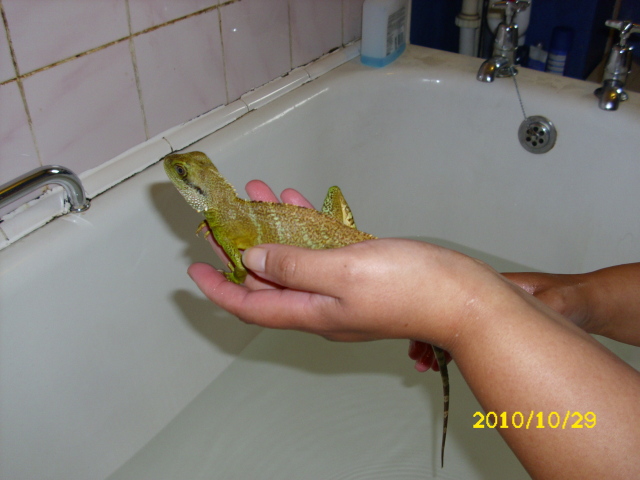 Re: water dragon
Question
Rex the water dragon
Hi Tracie,
My water drag
Re: water dragon
Question
Rex the water dragon
Hi Tracie,
My water drag
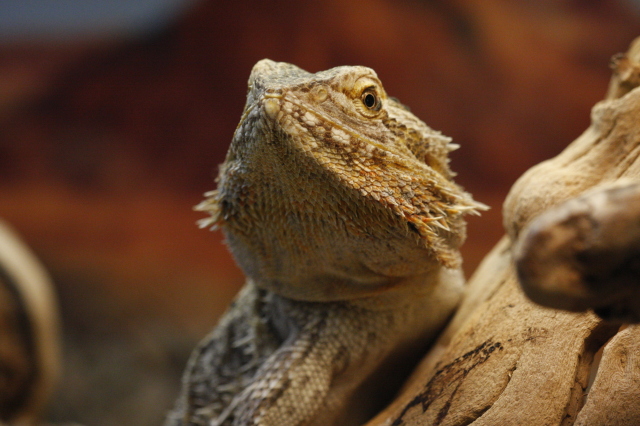 Bearded Dragon Will not Eat
QuestionQUESTION: My female bearded dragon (8 years old
Bearded Dragon Will not Eat
QuestionQUESTION: My female bearded dragon (8 years old
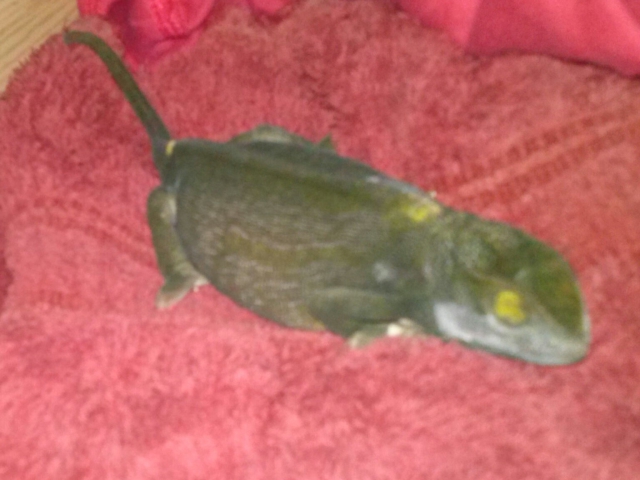 Flap neck Chameleon. Urgent help PLEASE!
QuestionPaula about 8 hrs afte
Paula straight af
Flap neck Chameleon. Urgent help PLEASE!
QuestionPaula about 8 hrs afte
Paula straight af
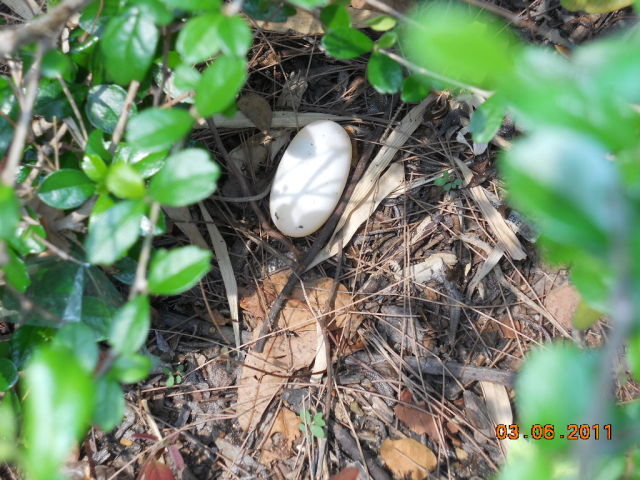 Snake egg identification
Question
Snake Egg
This egg was found in the American E
Snake egg identification
Question
Snake Egg
This egg was found in the American E
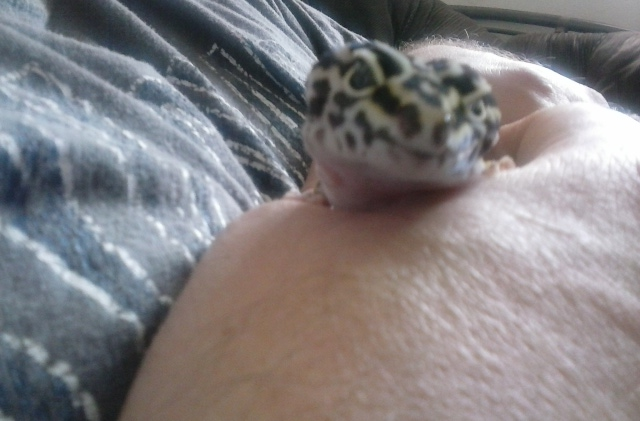 Leopard gecko mouth scab
Question
Front view pic 2
Hello! I have a
Leopard gecko mouth scab
Question
Front view pic 2
Hello! I have a